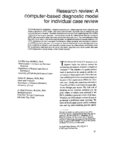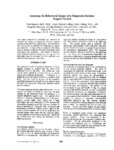1 - 25 of 18
| Creator | Title | Description | Subject | Date | ||
|---|---|---|---|---|---|---|
| 1 |
 |
Warner, Homer R. | A Computer-Based Diagnostic Model for Individual Case Review | Biomedical Informatics | 1995 | |
| 2 |
 |
Warner, Homer R. | Assessing the Behavioral Impact of a Diagnostic Decision Support System | Biomedical Informatics | 1995 | |
| 3 |
 |
Warner, Homer R. | Computerized Practice Guidelines for Heart Failure Management: The HeartMan System | Biomedical Informatics | 1995 | |
| 4 |
 |
Gesteland, Raymond F.; Krapcho, Karen J.; Talbot, Phil; Thulin, Craig | Crystallization of the MS2 translational repressor alone and complexed to bromouridine | The coat protein from the MS2 bacteriophage plays a dual role by encapsidating viral RNA and also by binding RNA as a translational repressor. In order to study the isolated dimer in a conformation not influenced by capsid interactions, a mutant molecule was crystallized that is defective in capsid ... | Crystallization; RNA Bacteriophage; RNA Hairpin; Translational Repressor | 1995 |
| 5 |
 |
Warner, Homer R. | Enroute Toward a Computer-Based Patient Record: The ACIS Project | Biomedical Informatics | 1995 | |
| 6 |
 |
Baehr, Wolfgang | Guanylyl cyclase activating protein. A calcium-sensitive regulator of phototransduction | Guanylyl cyclase activating protein (GCAP1) has been proposed to act as a calcium-dependent regulator of retinal photoreceptor guanylyl cyclase (GC) activity. Using immunocytochemical and biochemical methods, we show here that GCAP1 is present in rod and cone photoreceptor outer segments where photo... | Cloning, Molecular; DNA Primers; Molecular Sequence Data | 1995 |
| 7 |
 |
Bernstein, Paul S. | Human retinal pigment epithelial cell line that retains epithelial characteristics after prolonged culture | PURPOSE. A spontaneously arising, apparently transformed, cell line has been cloned from a primary culture of human retinal pigment epithelial (RPE) cells and has been subcultured more than 200 times. The similarities of these cells to human RPE cells in vivo have been determined. METHODS. The struc... | Cell Line, Transformed; Chromatography, High Pressure Liquid; Phagocytosis | 1995 |
| 8 |
 |
Angelucci, Alessandra | Layer-specific programs of development in neocortical projection neurons | How are long-range axonal projections from the cerebral cortex orchestrated during development? By using both passively and actively transported axonal tracers in fetal and postnatal ferrets, we have analyzed the development of projections from the cortex to a number of thalamic nuclei. We report th... | Axonal Transport; Efferent Pathways; Brain Mapping | 1995 |
| 9 |
 |
Kriesel, John D. | Miliary Tuberculosis and the postpartum state | In 1985, a resurgence of tuberculosis began in the United States. In conjunction with this resurgence, there has been an increase in the number of atypical presentations of the disease. We recently treated a patient who had disseminated tuberculosis that became manifest in the postpartum state. Wher... | Miliary tuberculosis; Postpartum | 1995 |
| 10 |
 |
Kestle, John R. W. | Natural history of cerebral cavernous malformations | To determine the natural history of brain cavernous malformations, the authors entered patients referred to their center into a prospective registry between 1987 and 1993. All patients underwent magnetic resonance imaging, which showed the typical appearance of this lesion, and conservative manageme... | Cavernous malformation; Vascular malformation; Seizure | 1995 |
| 11 |
 |
Rogers, Alan R.; Jorde, Lynn B. | Origins and affinities of modern humans: a comparison of mitochondrial and nuclear genetic data | To test hypotheses about the origin of modern humans, we analyzed mtDNA sequences, 30 nuclear restriction-site polymorphisms (RSPs), and 30 tetranucleotide short tandem repeat (STR) polymorphisms in 243 Africans, Asians, and Europeans. An evolutionary tree based on mtDNA displays deep African branch... | Base Sequence; Variation (Genetics); Base Sequence | 1995 |
| 12 |
 |
Couldwell, William T. | Pallidotomy in advanced Parkinson's disease | To the Editor: We read with interest the comments published regarding our recent article on pallidotomy in patients with advanced Parkinson's disease (3). There seems to be confusion as to some of the technical methods used in creating the radiofrequency lesions in these patients. As noted in the Pa... | Pallidotomy; Dyskinesia | 1995 |
| 13 |
 |
Couldwell, William T. | Paradoxical elevation of Ki-67 labeling with protein kinase inhibition in malignant gliomas | The monoclonal antibody Ki-67 recognizes a nuclear antigen expressed in the G1, S, G2, and M phase of the cell cycle and has been used extensively as an indicator of cellular proliferation in malignant gliomas, both in the laboratory and clinically. Recently, protein kinase C (PKC) inhibitors have b... | Brain neoplasm; Chemotherapy; Glioma; Monoclonal antibody; Ki-67; Protein kinase C; Tamoxifen | 1995 |
| 14 |
 |
Dailey, Andrew T. | Pathophysiology of oral pharyngeal apraxia and mutism following posterior fossa tumor resection in children | Mutism following posterior fossa tumor resection in pediatric patients has been previously recognized, although its pathophysiology remains unclear. A review of the available literature reveals 33 individuals with this condition, with only a few adults documented in the population. All of these pati... | Vermis; Posterior fossa tumor; Pediatric patients | 1995 |
| 15 |
 |
Kestle, John R. W. | Reduction of hemorrhage risk after stereotactic radiosurgery for cavernous malformations | The benefits of radiosurgery for cavernous malformations are difficult to assess because of the unclear natural history of this vascular lesion, the inability to image malformation vessels, and the lack of an imaging technique that defines "cure." The authors selected for radiosurgery 47 patients w... | Cavernous malformation; Gamma knife; Stereotactic radiosurgery | 1995 |
| 16 |
 |
Kestle, John R. W. | Relationship of intraoperative electrophysiological criteria to outcome after selective functional posterior rhizotomy | At British Columbia's Children's Hospital, the criteria used in selective functional posterior rhizotomy (SFPR) evolved in three distinct phases. In Phase 1 the electrophysiological criteria for abnormality included a low threshold to a single stimulation, a sustained response to 50-Hz stimulation, ... | Selective posterior rhizotomy; Electrophysiological criteria; Intraoperative electrical stimulation | 1995 |
| 17 |
 |
Kestle, John R. W. | Simple risk predictions for arteriovenous malformation hemorrhage | WE PRESENT A simple risk prediction formula for arteriovenous malformation hemorrhage. Natural history studies have shown an annual risk of hemorrhage of 2 to 4% for patients with brain arteriovenous malformations. Although decision analysis programs and biostatistical models are available to predic... | Arteriovenous malformation; Hemorrhage risk; Prediction formula | 1995 |
| 18 |
 |
Couldwell, William T. | Ventroposterior medial pallidotomy in patients with advanced Parkinson's disease | IN A PRELIMINARY study, the effects of ventroposterior medial pallidotomy were evaluated in five patients with advanced Parkinson's disease in whom medical therapy had failed. The mean age was 67.0 ? 5.6 years, and t h e mean Hoelin and Yahr stage when "off" was 3.9 ? 1.3. Three patients received u... | Pallidotomy; Dyskinesia; Stereotaxy; Postoperative morbidity | 1995 |
1 - 25 of 18
